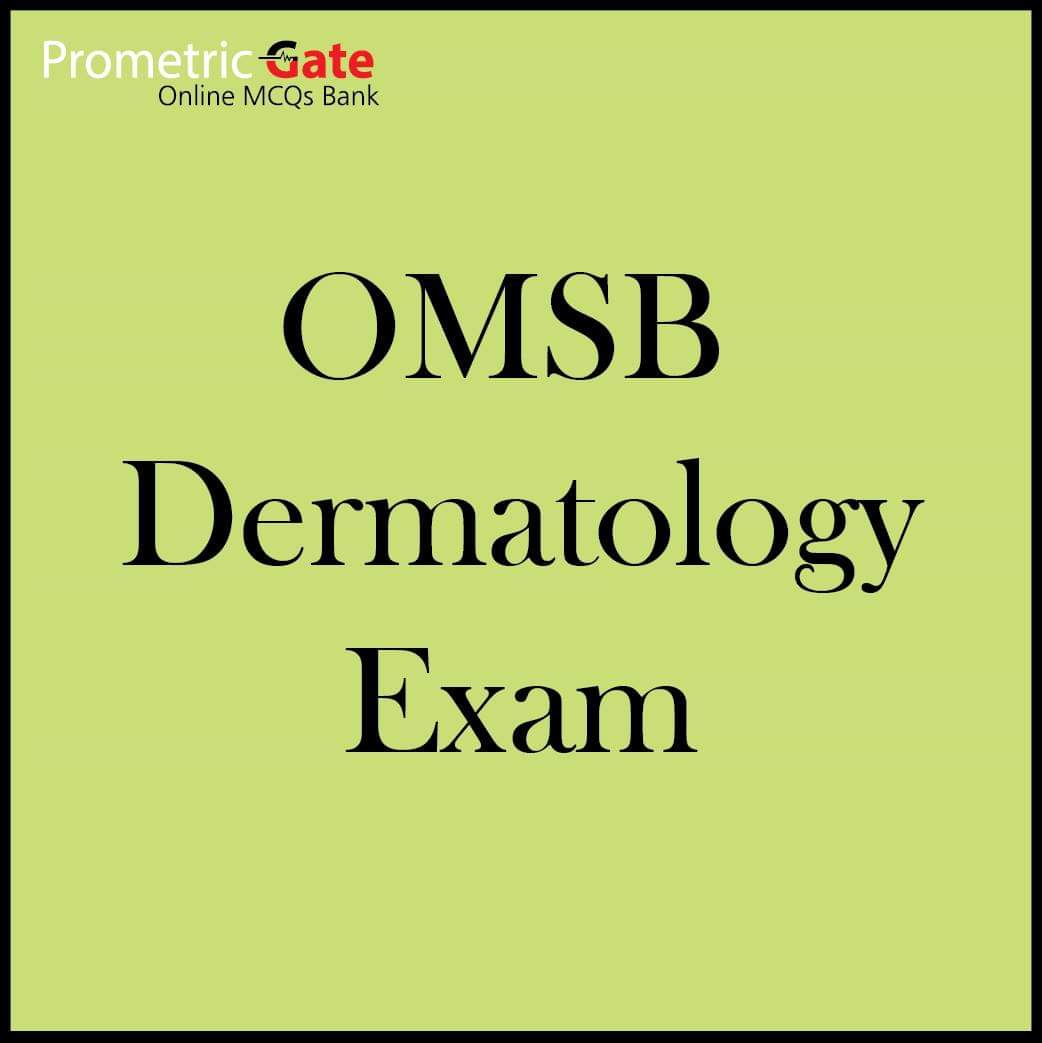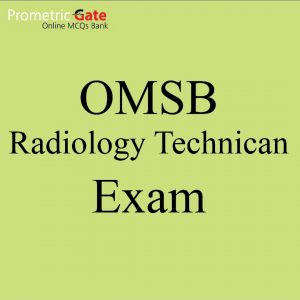OMAN Dermatology Exam Course Materials 2024
(6000 MCQs with explanations)
Study materials more than 9000 new MCQs (with explanation for each question) for those preparing for OMSB Exam for Dermatology Specialist.
Samples :
A 53-year-old man is taking multiple medications presents with target lesions, raised edematous papules, distributed acrally, and hemorrhagic crusting lips. Which of the following is the most likely diagnosis?
A. Erythema multiforme
B. Erythema nodosum
C. Pityriasis alba
D. Stevens–Johnson syndrome
Answer: A
- Erythema multiforme (EM) is an acute, self-limited, and sometimes recurring skin condition that is considered to be a type IV hypersensitivity reaction associated with certain infections, medications, and other various triggers.
- Characterized by the sudden onset of erythematous “target-like” lesions and usually follows herpes simplex infection.
- This condition presents with targe-tlike lesions that especially occur on the palms and soles.
Erythema multiforme is caused by the following:
- Sulfa drugs (most common)
- Penicillin
- Antibiotics
- Phenytoin
- Allopurinol
A 50-year-old woman presented with muscle aches and non-itchy skin rash on face for the past month. No history of prolonged drug intake. On examination, there was edematous purplish erythema on forehead and eyelids, and purplish papules on knuckles of hands. There was proximal limb muscle weakness. Which of the following is the most likely diagnosis?
A. Dermatomyositis
B. Lichen planus
C. Rosacea
D. Systemic lupus erythematosus
E. Systemic scleroderma
Answer: A
Dermatomyositis is a long-term inflammatory disorder which affects muscles. Its symptoms are generally a skin rash and worsening muscle weakness over time. These may occur suddenly or develop over months. Other symptoms may include weight loss, fever, lung inflammation, or light sensitivity. Complications may include calcium deposits in muscles or skin.
The cause is unknown. Theories include that it is an autoimmune disease or a result of a viral infection. It is a type of inflammatory myopathy. Diagnosis is typically based on some combination of symptoms, blood tests, electromyography, and muscle biopsies.
While there is no cure for the condition, treatments generally improve symptoms. Treatments may include medication, physical therapy, exercise, heat therapy, orthotics, and assistive devices, and rest.
Medications in the corticosteroids family are typically used with other agents like methotrexate or azathioprine recommended if steroids are not working well. Intravenous immunoglobulin may also improve outcomes. Most people improve with treatment and in some, the condition resolves completely.
Patient with psoriasis, took a medication then developed generalized psoriasis covering all his body surface, what is the percentage of the involved body surface?
A. 30%
B. 50%
C. 70%
D. 90%
Answer: D
Psoriasis is a long-lasting autoimmune disease characterized by patches of abnormal skin. These skin patches are typically red, itchy, and scaly. Psoriasis varies in severity from small, localized patches to complete body coverage. Injury to the skin can trigger psoriatic skin changes at that spot, which is known as the Koebner phenomenon.
There are five main types of psoriasis: plaque, guttate, inverse, pustular, and erythrodermic. Plaque psoriasis, also known as psoriasis vulgaris, makes up about 90 percent of cases. It typically presents as red patches with white scales on top. Areas of the body most commonly affected are the back of the forearms, shins, navel area, and scalp. Guttate psoriasis has drop-shaped lesions. Pustular psoriasis presents as small non-infectious pus-filled blisters. Inverse psoriasis forms red patches in skin folds. Erythrodermic psoriasis occurs when the rash becomes very widespread, and can develop from any of the other types. Fingernails and toenails are affected in most people with psoriasis at some point in time. This may include pits in the nails or changes in nail color.
A 54-year-old woman comes to the doctor for skin tightness and painful fingertips with exposure to cold. Examinations shows thickened skin. Labs shows positive ANA and Anti-Scl-70 antibodies. Which of the following is the most likely diagnosis?
A. Behcet’s disease
B. CREST syndrome
C. Scleroderma
D. Systemic Lupus Erythematosus
Answer: C
- Scleroderma is a disorder characterized by diffuse fibrosis of skin and internal organs.
- Raynaud’ s phenomena are seen in most patients with scleroderma.
- Scleroderma is more common in women.
- Presents with arthralgias, myalgias, hand swelling, Raynaud phenomenon (i.e., blue distal extremities caused by arteriolar spasm),
skin thickening, esophageal dysmotility, intestinal hypomotility, dyspnea, possible arrhythmias or heart failure.
- Scleroderma patients have positive ANA and Anti-Scl-70 antibodies
Treatment
- There is no available treatment for scleroderma.
- Steroids for acute flares.
- Penicillamine can be used for skin changes.
- Calcium channel blockers for Raynaud’s.
- ACEIs for renal disease and malignant hypertension
A 27-year-old male is brought by his parent because of loss of hair. On examination: he had localized patch of hair loss at temporal area, the end of hair looked bro- ken and tapered. What is the diagnosis?
A.Alopecia areata
B. Alopecia universalis
C. Androgenic alopecia
D. Trichotillomania
Answer: D
Trichotillomania (TTM), also known as hair pulling disorder, is an impulse control disorder characterised by a long term urge that results in the pulling out of one’s hair. This occurs to such a degree that hair loss can be seen. Efforts to stop pulling hair typically fail. Hair removal may occur anywhere; however, the head and around the eyes are most common. The hair pulling is to such a degree that it results in distress.
The disorder may run in families. It occurs more commonly in those with obsessive compulsive disorder. Episodes of pulling may be triggered by anxiety. People usually acknowledge that they pull their hair. On examination broken hairs may be seen. Other conditions that may present similarly include body dysmorphic disorder, however in that condition people remove hair to try to improve what they see as a problem in how they look.
A 64-year-old woman presents with diffuse hair loss. She says that her hair is “coming out by the handfuls” after shampooing. She was treated for severe community-acquired pneumonia 2 months ago but has regained her strength and is exercising regularly. She is taking no medications.
Examination reveals diffuse hair loss. Several hairs can be removed by gentle tugging. The scalp is normal without scale or erythema. Her general examination is unremarkable; in particular, her vital signs are normal, she has no pallor or inflammatory synovitis, and her reflexes are normal with a normal relaxation phase. What is the best next step in her management?
A. Measurement of serum testosterone and DHEA-S levels
B. Reassurance
C. Topical corticosteroids
D. Topical minoxidil
Answer: B
This patient’s diffuse hair loss after a severe illness is caused by telogen efluvium. Normal hair follicles go through a life cycle.
Approximately 5% are in the death (telogen) phase where the hair shaft is released. In telogen efluvium, the hair follicles are “shocked” by the systemic stress, and many enter the telogen phase at the same time.
The diagnosis is made by careful history and physical examination. CBC, ANA, and hormonal levels will be normal. Topical treatments are ineffective. The patient will recover fully in a month or two, although a wig may be necessary to hide cosmetically troubling alopecia in the meantime. Diffuse hair loss may be seen with many drugs or with systemic illnesses such as hypothyroidism, systemic lupus, syphilis, or iron deficiency, but there is no evidence of any of these illnesses in this patient. Male pattern baldness (androgen-dependent alopecia) is seen in normal men, in some older women, and in women with androgen excess, but the hair loss affects the crown and frontal region rather than the scalp diffusely. The dramatic and acute hair loss of telogen effluvium does not occur in male pattern baldness.





hassan qasimi –
Nice source